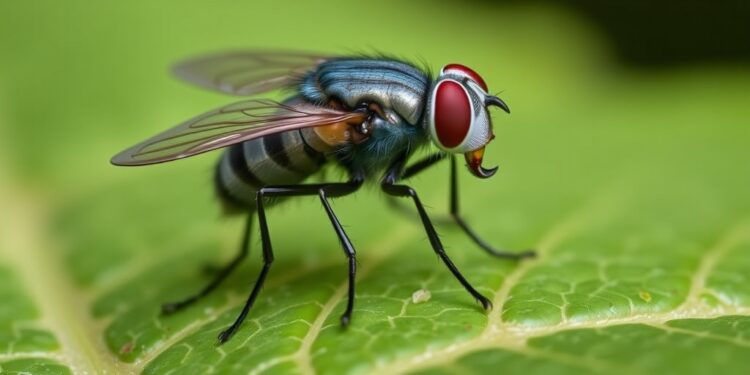
Researchers have made groundbreaking discoveries concerning the behavior of the vinegar fly, Drosophila melanogaster, that signify a remarkable shift in the way scientists perceive insect intelligence and behavior. Specifically, the study published in Current Biology reveals that these flies exhibit play-like behaviors, a phenomenon previously unobserved in insects. This not only sparks curiosity in the scientific community but also paves the way for deeper exploration into the cognitive abilities of non-human creatures.
Traditionally, play has been recognized as an important aspect of development in higher mammals, including humans. It has been associated with enhancing physical abilities, social skills, and cognitive development. By establishing that fruit flies can engage in voluntary, playful movements, scientists can now question the evolutionary advantages of such behaviors in simpler organisms. This compelling discovery urges researchers to evaluate the groundwork of behavioral science through a broader lens, seeking parallels between insect behavior and more complex forms of play observed in mammals.
The detailed analysis involved a meticulously designed experiment in partnership with Northumbria University, where scientists closely monitored the interactions of nearly 200 individual flies in a specialized carousel arena. The ingenious setup consisted of a transparent dome approximately one centimeter in height, allowing the researchers to capture and analyze the subtle movements of the flies over extended periods. Video recordings spanned anywhere from three days to two weeks, generating monumental amounts of data that would ultimately lead to reevaluating our understanding of what constitutes play.
Of significant interest was the flies’ varied responses to the carousel apparatus. Many flies exhibited avoidance behavior, while others demonstrated a propensity to revisit the carousel frequently, engaging with it for extended time frames. The research team noted that when two carousels were set to rotate alternately, certain flies appeared to actively follow the movements—a clear indication of intentional interaction rather than random or coincidental behavior.
To discern the nature of the flies’ movements—whether they were deliberate or instinctual—the researchers utilized advanced tracking software capable of interpreting the video data. This innovation proved crucial; it allowed the team to classify the flies’ approaches to the carousel as either purposeful or haphazard. Notably, the study found that unplanned visits to the carousel were relatively infrequent among those flies engaging in self-directed play.
The implications of these findings extend into realms beyond simple behavior observation. By understanding and cataloging the specific movements associated with play-like activities in Drosophila melanogaster, researchers can explore the genetic, neuronal, and biochemical underpinnings of such behaviors. As Huetteroth remarked, this information may illuminate how more complex creatures, including humans, develop self-awareness regarding their own physical existence.
Fruit flies have long served as model organisms in scientific research due to their relatively simple nervous systems, short lifespans, and the wealth of genetic tools available for manipulation. This study further enhances the importance of fruit flies in experimental research, pushing the boundaries to include not just genetic pathways, but also behavioral manifestations that can improve our understanding of cognition and perception in animals.
The meticulous data collection process saw researchers interpreting approximately seven years’ worth of film data in order to yield meaningful insights. The study makers had to navigate the uniquely challenging aspect that flies do not naturally interact with carousel devices without external stimuli, which complicated standard observational methodologies. However, this level of scrutiny allowed for the differentiation between spontaneous actions and intention-driven behaviors.
Future investigations, as envisioned by the researchers, will be centered around the genetic mechanisms that facilitate such play behaviors. By identifying specific genes and neuronal circuits responsible for this activity, scientists may cast light on how play contributes not only to individual development but may also hold evolutionary significance across the animal kingdom. Moreover, this exploration might serve to bridge cognitive science with evolutionary biology, forging connections that have remained largely unexplored.
In essence, the research opens a new chapter in behavioral science, suggesting that play could be an innate trait in simpler organisms, challenging the assumption that cognitive playfulness is reserved for complex brains. As scientists continue to delve deeper into the nuances of fly behavior, the potential for uncovering broader principles of animal behavior, learning, and even emotional intelligence looms large on the horizon.
This groundbreaking work marks a pivotal moment in understanding animal behavior, inviting further investigations leading us toward a new paradigm concerning the inner workings of even the most seemingly simple of beings. The findings meticulously crafted in this study will surely incite substantial dialogue among scientists and lay enthusiasts alike, ultimately expanding our appreciation for the rich tapestry of life.
As this research gets disseminated, it will undoubtedly inspire future studies and innovations aimed at unpacking the myriad complexities that characterize the fascinating world of animal behavior. With every step into this uncharted territory, we inch closer to unraveling some of the most profound questions regarding consciousness, play, and the evolutionary narratives that underpin them.
—
Subject of Research: Animals
Article Title: Play-like behavior exhibited by the vinegar fly Drosophila melanogaster
News Publication Date: 10-Feb-2025
Web References: http://dx.doi.org/10.1016/j.cub.2025.01.025
References: Current Biology
Image Credits: (not provided)
Keywords: Vinegar fly, Drosophila melanogaster, play behavior, animal cognition, behavioral science
Tags: behavioral science in insectscognitive abilities in non-human creaturesDrosophila melanogaster behaviorevolutionary advantages of playfruit fly social interactionsgroundbreaking discoveries in entomologyinsect cognition studiesinsect intelligence researchNorthumbria University researchparallels between insect and mammal behaviorplay-like behaviors in insectsplayful behavior in insects





